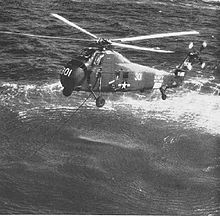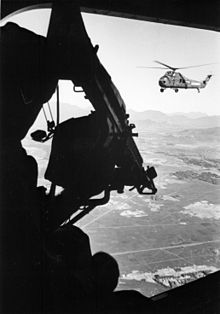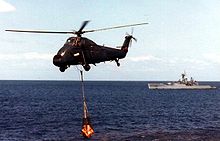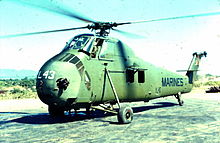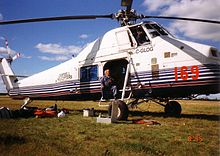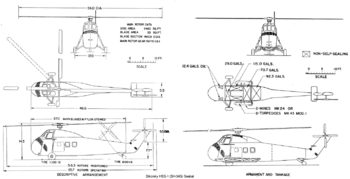- Sikorsky H-34
-
Sikorsky H-34/S-58 Role Helicopter Manufacturer Sikorsky Aircraft First flight 8 March 1954 Introduction 1954 Status out of production, still in civilian service Primary users United States Army
United States Navy
United States MarinesNumber built 2,108 Developed from H-19 Chickasaw Variants Westland Wessex The Sikorsky H-34 Choctaw (Company designation S-58) was a piston-engined military helicopter originally designed by American aircraft manufacturer Sikorsky for the United States Navy for service in the anti-submarine warfare (ASW) role.
Sikorsky H-34s have since served mostly as medium transports on every continent with the armed forces of twenty-five countries — from combat in Algeria, the Dominican Republic, Nicaragua, and throughout Southeast Asia, to saving flood victims, recovering astronauts, fighting fires, and carrying presidents. As one of the last piston-powered helicopter designs before its replacement by turbine-powered types such as the UH-1 Huey and CH-46 Sea Knight, it would see a remarkably long run of 2,108 H-34s produced between 1953 and 1970.[1] It would see extended use when adapted to turbine power by the British licencee as the Westland Wessex and Sikorsky as the later S-58T. The British did not retire the Wessex until 2003 as the main transport helicopter; it was replaced by the Aérospatiale Puma.
Contents
Development
The Sikorsky S-58 was developed as essentially a lengthened and more powerful version of the Sikorsky (model S-55) or UH-19 Chickasaw, with a similar nose, but with a tail-dragger rear fuselage and landing gear rather than the high-tail 4 post pattern. It retained the nose-mounted piston engine with the drive shaft passing the cockpit placed high above the cargo compartment.
The aircraft first flew on 8 March 1954. The first production aircraft was ready in September and entered in service for the United States Navy initially designated HSS-1 Seabat (in its anti-submarine configuration) and HUS-1 Seahorse (in its utility transport configuration) under the U.S. Navy designation system for U.S. Navy, United States Marine Corps (USMC) and United States Coast Guard (USCG) aircraft. The U.S. Army and Marine Corps, respectively, ordered it in 1955 and 1957. Under the United States Army's aircraft designation system, also used by the United States Air Force, the helicopter was designated H-34. The U.S. Army also applied the name Choctaw to the helicopter. In 1962, under the new unified DoD aircraft designation system, the Seabat was redesignated SH-34, the Seahorse as the UH-34, and the Choctaw as the CH-34.
Roles included utility transport, anti-submarine warfare, search and rescue, and VIP transport. In it standard configuration transport versions could carry 12 to 16 troops, or eight stretcher cases if utilized in the MedEvac role, while VIP transports carried significantly fewer people in significantly greater comfort.
A total of 135 H-34s were built in the U.S. and assembled by Sud-Aviation in France, 166 were produced under licence in France by Sud-Aviation for the French Air Force, Navy and Army Aviation (ALAT).
The CH-34 was also built and developed under license from 1958 in the United Kingdom by Westland Aircraft as the turbine engined Wessex which was used by the Royal Navy and Royal Air Force. The RN Wessex was fitted out with weapons and ASW equipment for use in an antisubmarine role. The RAF used the Wessex, with turboshaft engines, as an air/sea rescue helicopter and as troop transporter. Wessexes were also exported to other countries and produced for civilian use.
Operational history
US Coast Guard
The U.S. Coast Guard flew the HUS-1G (later HH-34F) helicopter, with inflatable flotation gear, from 1959 to 1962.
US Marine Corps
The USMC also obtained a variant with inflatable flotation gear designated HUS-1A ("UH-34E"), equivalent to US Coast Guard helicopters.
The HSS-1 Seabat could carry an AN/AQS-4 or -5 dipping sonar, and a homing torpedo or depth charge on each side of the fuselage. Another possible external store was a 568 liter (150 US gallon) external tank. The US Navy helicopter developed a night-capable subvariant, the "HSS-1N" ("SH-34J"), which featured Doppler navigation radar, plus an automatic stabilization system.
After the introduction of the Sikorsky S-61 Sea King for ASW duties, some Seabats were stripped of ASW gear for utility duties, being designated UH-34G or UH-34J. A batch of 14 Navy UH-34Js was handed over to the USAF for the SAR role, being redesignated HH-34J.
US Army
The US Army liked the S-58, ordering it as the H-34A, H-34B and H-34C Choctaw, later named CH. The H-34A could carry 16 troops or 8 stretchers.
Four HUS-1L (later LH-34D) were ordered for Arctic operations, and five HUS-1Z (later VH-34D) VIP machines were ordered for the Presidential Flight Detachment.
Vietnam War
French evaluations on the reported ground fire vulnerabilities of the CH-34 may have influenced the U.S. Army's decision to deploy the CH-21 Shawnee to Vietnam instead of the CH-34, pending the introduction into widespread service of the Bell UH-1 Iroquois. U.S. Army H-34s did not participate in Vietnam, and did not fly in the assault helicopter role, however a quantity were supplied to the Army of the Republic of Vietnam. These saw little use due lack of spare parts and maintenance.[2]
The USMC continued to use the H-34 pattern, even after the U.S. Army had phased it out. Even after the USMC adopted their own version of the UH-1, the UH-1E, the CH-34s continued to be used up to and for a period after the Tet Offensive in 1968. They were often armed, with a machine gun on a flexible door mount or window mount, initially a Browning 7.62 millimeter later replaced by the lighter 7.62 millimeter M60. Armor was also eventually added to protect the engine and crew.[citation needed]
Its higher availability and reliability due to its simplicity compared to the newer helicopters led Marines to ask for it by name. The phrases "give me a HUS", "get me a HUS" and "cut me a HUS" entered the USMC vernacular, being used even after the type was no longer in use to mean "help me out".[3]
USMC H-34s were also among the first gunship helicopters trialled in theatre, being fitted with the Temporary Kit-1 (TK-1), comprising two M60C machine guns and two 19 shot 2.75 inch rocket pods. The operations were met with mixed enthusiasm, and the armed H-34s, known as "Stingers" were quickly phased out. The TK-1 kit would form the basis of the TK-2 kit used on the UH-1E helicopters of the USMC.
On August 18, 1969, the last Marine UH-34D in Vietnam was retired from HMM-362 at Phu Bai. During that period, enemy action and accidents downed 134 helicopters. Most of the twenty surviving CH-34 helicopters were turned over to the South Vietnamese during the course of the war, though a few were ultimately reclaimed by the Army prior to the final collapse of the Saigon Government.[citation needed]
Post-Vietnam War
The H-34 remained in service with United States Army and Marine Corps aviation units well into the late 1960s, and was standard equipment in Marine Corps Reserve, Army Reserve and Army National Guard aviation units until replaced by the UH-1 Iroquois utility helicopter. Sikorsky production ceased in 1968, with 1,821 built.[4] On 3 September 1973, the last flight of a USMC UH-34 occurred as bureau number 147191 was flown to MCAS New River.[5] All H-34 helicopters were retired from service in the U.S. military by the early 1970s.
France
The French Navy and Armée de l’Air adopted the SH-34 Seabat and H-34, using the helicopter during the Algerian War of 1956-62. The French operated their Sikorsky S- 58s in troop insertions/extractions, medical evacuations, SAR, and resupply missions throughout Algeria, especially in the mountain strongholds of the rebels. Their crews wore bullet-proof vests and some armor was added.[citation needed]
France bought 134 Choctaws in parts from the United States and assembled by Sud-Aviation. A further 166 were manufactured later locally for the French Army, Navy and Air force, these again produced by Sud-Aviation.[6]
United Kingdom
The Wessex saw considerable combat service with the British. The RAF used them in Northern Ireland, Aden, Oman and in the counter-insurgency operation in Malaysia in the early 1960s. The Wessex also saw combat with the RN and Royal marines in the 1982 Falklands War, with a HAS.3 disabling an Argentinian submarine SANTA with depth charges and machine-gun fire. The Wessex went on in UK military service into the early 1990s.[citation needed]
South Vietnam
The H-34 was the primary VNAF helicopter until replaced by the Bell UH-1 Huey.[7]
Israel
A joint air force/paratroops delegation studied helicopters used by the French Army Aviation and recommended the acquisition of the Sikorsky S-58 and on 13 February 1958, the first pair arrived in Israel, followed by another helicopter in March. The "Rolling Sword" squadron, which operated all IAF helicopters at the time, operated only a few examples until 1962 when 24 S-58s earmarked for the West German air force were covertly routed to Israel.[citation needed]
At the outbreak of the Six Days War the "Rolling Sword" squadron had 28 airworthy S-58s. The helicopters began the war evacuating downed pilots, but became more involved as the ground war progressed. On the night of 5-6 June, the S-58s airlifted 600 soldiers behind Egyptian lines in the center of the Sinai Peninsula after Israeli armor had met fierce resistance. This ground force destroyed an Egyptian artillery position, hastening the collapse of the Egyptian front. On 7 June, S-58s were tasked with airlifting Israeli paratroops to capture the southernmost point in the Sinai, Sharm el-Sheikh, but arrived at the site to find it abandoned.[citation needed]
During the final operation of the war, the conquest of the Golan Heights from the Syrians, the S-58s flew Israeli paratroops in to take control of the southern Golan. In three separate airlifts on June 9-10, the paratroops were inserted behind Syrian lines and attacked retreating Syrian forces.[citation needed]
The S-58 continued to fly combat missions after the end of the war, mainly against Palestinians infiltrating Israel or against their bases in Jordan. On 21 March 1968, they participated in the Battle of Karameh, bringing Israeli troops in and out as well as evacuating the wounded. This was the last operation of the S-58 as it was retired shortly later, replaced by the Bell 205 and Aérospatiale Super Frelon.[8]
Civilian use
- The H-34's lift capacity was just sufficient to lift a Mercury capsule. In 1961, the hatch of Mercury 4 was prematurely detached and the capsule was filled with seawater. That extra weight was too much for the H-34 and Liberty Bell 7 was emergency released and sank in deep water).[9]
- In the 1990s, an S-58ET called Miss Piggy from "New York Helicopter" flew passengers from JFK International Airport to East 34th Street Heliport, New York.[10]
- H-34 have been used by forest firefighting contractors in Ontario.
- At least one S-58 was purchased for civilian use by Oregon-based Columbia Helicopters in the 1960s.[11]
- In 1968, an S-58 was used to remove the wreckage of a Bell 47 G2 helicopter from the top of Uluru (Ayers Rock) in central Australia.
- The 1980s television series Riptide featured a military-surplus H-34 called "The Screaming Mimi".[12]
Variants
- H-34A
- U.S. Army version of the HSS-1 powered by a 1,525 hp R-1820-84, re-designated CH-34A in 1962, 359 built and 21 transferred from the U.S. Navy.
- JH-34A
- Designation for H-34A used for weapon tests.
- VH-34A
- Staff transport conversions of H-34A.
- H-34B
- H-34As converted with detail changes, became CH-34B in 1962.
- H-34C
- H-34B design with detail changes converted from H-34As, became CH-34C in 1962.
- JH-34C
- Designation for CH-34C used for weapon tests.
- VH-34C
- Staff transport conversions of CH-34C.
- HH-34D
- Designation applied to aircraft given USAF serials to be transferred under MAP and MDAP.
- LH-34D
- HUS-1L re-designated in 1962
- UH-34D
- HUS-1 re-designated in 1962 and 54 new build.
- VH-34D
- HUS-1Z re-designated in 1962
- UH-34E
- HUS-1A re-designated in 1962
- HH-34F
- HUS-1G re-designated in 1962
- YSH-34G
- YHSS-1 re-designated in 1962
- SH-34G
- HSS-1 re-designated in 1962
- SH-34H
- HSS-1F re-designated in 1962
- YSH-34J
- YHSS-1N re-designated in 1962
- SH-34J
- HSS-1N re-designated in 1962
- UH-34J
- SH-34J without ASW equipment for cargo and training purposes.
- HH-34J
- Ex-USN UH-34Js operated by the U.S. Air Force
- VH-34J
- Staff transport conversions of SH-34J.
- XHSS-1 Seabat
- Three Sikorsky S-58s for evaluation by the U.S. Navy, re-designated YHSS-1 then YSH-34G in 1962.
- HSS-1 Seabat
- Production Anti-Submarine model for the U.S. Navy, re-designated SH-34G in 1962, 215 built
- HSS-1F Seabat
- One HSS-1 re-engined with two YT-58-GE as a flying test bed, re-designated SH-34H in 1962.
- YHSS-1N Seabat
- One HSS-1 converted as the HSS-1N prototype, re-designated YSH-34J in 1962.
- HSS-1N Seabat
- Night/Bad weather version of the HSS-1 with improved avionics and autopilot, re-designated SH-34J in 1962, 167 built (an addition 75 HSS-1 airframes were built to CH-34C standard for West Germany).
- HUS-1 Seahorse
- Utility transport version of the HSS-1 for the U.S. Marine Corps, re-designated UH-34D in 1962, 462 built
- HUS-1A Seahorse
- Forty HUS-1s fitted with amphibious pontoons, re-designated UH-34E in 1962.
- HUS-1G Seahorse
- United States Coast Guard version of the HUS-1, re-designated HH-34F in 1962, six built.
- HUS-1L Seahorse
- Four HUS-1s converted for antarctic operations with VXE-6, re-designated LH-34D in 1962.
- HUS-1Z Seahorse
- Seven HUS-1s fitted with VIP interior for the Executive Flight Detachment, re-designated VH-34D in 1962.
- S-58
- Commercial designation for basic cargo variant
- S-58B
- Commercial designation for improved cargo variant
- S-58C
- Commercial passenger transport/airliner version
- S-58D
- Commercial airliner/freighter version
- S-58T
- Commercial conversions to turboshaft power by Sikorsky, Orlando Helicopter, and California Helicopter.
- S-58 Heli-Camper
- Commercial conversion, fitted with a Wright Cyclone R-1820-24 engine.
- Orlando Airliner
- Commercial conversion. 18-seat passenger transport helicopter.
Operators
- Argentine Naval Aviation
- Haiti Air Corps
- Imperial Iranian Air Force
- Vietnam Air Force total of 34 CH-34 for KingBee 219th Squadron.
 Spain
Spain Republic of China (Taiwan)
Republic of China (Taiwan) Turkey
Turkey Thailand
Thailand United States
United States
Accidents and incidents
- 27 July 1960 Chicago Helicopter Airways Flight 698 a S-58C registered N879 crashed into Forest Home Cemetery, Forest Park, Illinois, United States with the loss of 11 passengers and two crew. The investigation concluded that the helicopter became uncontrollable as a result of structural disintegration in flight caused by a fatigue failure of the main rotor blade.[13]
- 13 March 2011 Sikorsky S-58ET, N33602, suffered an engine failure, descended and veered off the side of an office building in El Segundo, California, while lifting an external load from the roof. The commercial pilot was seriously injured, the helicopter was substantially damaged and consumed by a post impact fire. The helicopter was registered to Heli Flight, Inc., and operated by Aris Helicopters.[14]
Aircraft on display
- There is a UH-34D Seahorse on display on the flight deck of the USS Yorktown (CV-10) at the Patriot's Point Naval and Maritime Museum in Charleston, South Carolina.[15]
- Sikorsky S-58T, H4K-64/30 / 20117 (cn 58-1117) at the Royal Thai Air Force Museum, Bangkok, Thailand.[16]
- Sikorsky UH-34D Seahorse (S-58A) 150556 (cn 58-1683) at Royal Thai Air Force Museum, Bangkok, Thailand.[16]
- Sikorsky 1954 H-34C Choctaw Serial # 054496 located at Carolinas Aviation Museum in Charlotte, North Carolina.[17]
- 1958 Sikorsky UH-34J Sea Bat Serial #145694 at the Wings of Freedom Aviation Museum, Naval Air Station Willow Grove, Willow Grove, Pennsylvania[18]
Specifications (H-34 Choctaw)
General characteristics
- Crew: 2
- Capacity: 16 troops or 8 stretchers
- Length: 56 ft 8.5 in (17.28 m)
- Rotor diameter: 56 ft 0 in (17.07 m)
- Height: 15 ft 11 in (4.85 m)
- Disc area: 2,463 ft² (228.85 m²)
- Empty weight: 7,900 lb (3,583 kg)
- Max takeoff weight: 14,000 lb (6,350 kg)
- Powerplant: 1 × Wright R-1820-84 radial engine, 1,525 hp (1,137 kW)
Performance
- Maximum speed: 123 mph (107 kn, 198 km/h)
- Range: 293 km (182 mi)
Armament
- Various (See Main Article: U.S. Helicopter Armament Subsystems)
See also
- Related development
- Aircraft of comparable role, configuration and era
- Related lists
- List of military aircraft of the United States
- List of helicopters
- List of civil aircraft
References
Notes
- ^ "H-34." Warplanes.net. Retrieved: 30 December 2010.
- ^ Mesko 1984, pp. 4–6.
- ^ Fails 1995, p. 9.
- ^ Endres, Günter G. Jane's Helicopter Markets and Systems. Coulsdon, Surrey, UK: Jane's Information Group, 1996. ISBN 978-0710613639.
- ^ Fails 1995, p. 127.
- ^ "Sikorsky H-34 / CH-34 Choctaw."militaryfactory.com. Retrieved: 17 January 2011.
- ^ The Vietnamese Air Force, 1951-1975. An Analysis of Its Role in Combat and Fourteen Hours at Koh Tang. Volume 3, USAF Southeast Asia monograph series 4 and 5. Washington D.C.: Office of Air Force History, 1985.
- ^ Gunston 1982, p. 92.
- ^ Wade, Mark. "Mercury MR-4." astronautix.com, 29 April 2009. Retrieved (from archive): 26 July 2011.
- ^ Brown, Allan. "S-58ET from New York Helicopter." airliners.net. Retrieved: 17 January 2011.
- ^ "History." Columbia Helicopters. Retrieved: 17 January 2011.
- ^ "Riptide — Helicopter TV show." rotaryaction.com, Pigaus Press, 2005. Retrieved: 5 March 2009.
- ^ "CAA 429 World Airline Accident Summary with reference to Civil Aeronautics Board Aircraft Accident Report SA-357." United Kingdom CAA Document.
- ^ "NTSB Identification: WPR11FA163." ntsb.gov. Retrieved: 26 July 2011.
- ^ "UH-34D Seahorse, Sikorsky." Patriot's Point Naval and Maritime Museum. Retrieved: 26 July 2011.
- ^ a b "Building 5: Helicopters and last propeller fighter." Royal Thai Air Force Museum. Retrieved: 17 January 2011.
- ^ "Helicopters." Carolinas Aviation Museum. Retrieved: 26 July 2011.
- ^ "Sikorsky UH-34J 'Sea Bat'." Wings of Freedom Aviation Museum. Retrieved: 26 July 2011.
Bibliography
- Duke, R.A. Helicopter Operations in Algeria [Translated French]. Washington, DC: Dept. of the Army, 1959.
- Fails, William R. Marines & Helicopters, 1962-1973. Darby, Pennsylvania: Diane Publishing, 1995. ISBN 0-7881-1818-8.
- Gunston, Bill. An Illustrated Guide To the Israeli Air Force. London: Salamander Books, 1982. ISBN 978-0668055062.
- Leuliette, Pierre. St. Michael and the Dragon: Memoirs of a Paratrooper, New York: Houghton Mifflin, 1964.
- Mesko, Jim: Airmobile: The Helicopter War in Vietnam. Carollton, Texas: Squadron/Signal Publications, 1984. ISBN 0-89747-159-8.
- Riley, David. "French Helicopter Operations in Algeria." Marine Corps Gazette, February 1958, pp. 21–26.
- Shrader, Charles R. The First Helicopter War: Logistics and Mobility in Algeria, 1954-1962. Westport, Connecticut: Praeger Publishers, 1999. ISBN 0-275-96388-8.
- Spenser, Jay P. Whirlybirds: A History of the U.S. Helicopter Pioneers. Seattle, Washington: University of Washington Press, 1998. ISBN 0-295-97699-3.
External links
- CH-34 U.S. Army Aviation history fact sheet
- Sikorsky H-34 Choctaw on shanaberger.com
- VNAF Kingbee 219th Squadron history fact sheet
USAAC/USAAF/USAF/Joint Service Helicopter designations 1941– Numerical sequence used by USAAC/USAAF/USAF 1941–Present; US Army 1948–1956 and 1962–present; US Navy 1962–presentMain sequence
Prefix R-, 1941–1948
Prefix H-, 1948–1962
H- with a mission prefix 1962–presentR-1 • R-2 • R-3 • R-4 • R-5/H-5 • R-6/H-6 • R-7 • R-8 • R-9/H-9 • R-10/H-10 • R-11/H-11 • R-12/H-12 • R-13/H-13/OH-13/UH-13J • R-14 • R-15/H-15 • R-16/H-16 • H-17 • H-18 • H-19/UH-19 • H-20 • H-21/CH-21 • H-22 • H-23/OH-23 • H-24 • H-25/UH-25 • XH-26 • H-27 • H-28 • H-29 • H-30 • H-31 • H-32 • H-33 • H-34/CH-34 • H-35 • (H-36 not assigned) • H-37/CH-37 • (H-38 not assigned) • XH-39 • H-40 • H-41 • H-42 • H-43/HH-43 • (H-44 and H-45 not assigned) • CH-46/HH-46 • CH-47 • UH-48 • H-49 • QH-50 • XH-51 • HH-52 • CH-53/HH-53/MH-53 • CH-54 • TH-55 • AH-56 • TH-57 • OH-58 • XH-59 • UH-60/SH-60/HH-60 • YUH-61 • XCH-62 • YAH-63 • AH-64 • HH-65 • RAH-66 • TH-67 • MH-68 • (H-69 not assigned) • ARH-70 • VH-71 • UH-72
1962 redesignations
reusing old numbersUSN helicopter designations pre-1962 Helicopter, Anti-submarine SikorskyHelicopter, Crane HCHHelicopter, Observation HillerHOESikorskyHelicopter, Trainer pre-1948 SikorskyHelicopter, Trainer 1948-1962 HillerHelicopter, Transport 1944-1962 Boeing VertolHRHSikorskyHelicopter, Utility pre-1949 HJDHJHSikorskyHJSHelicopter, Utility 1950-1962 HUK • HU2K
Bell:HUMSikorskyHUS • HU2S
Canadian Forces unified aircraft designations post-1968 100-125 126–150 151- Sikorsky Aircraft Fixed-wing aircraft S-1 · S-2 · S-3 · S-4 · S-5 · S-6 · S-7 · S-8 · S-9 · S-10 · S-11 · S-12 · S-13 · S-14 · S-15 · S-16 · S-17 · S-18 · S-19 · S-20 · S-21 · S-22 · S-23 · S-24 · S-25 · S-26 · S-27 · S-28 · S-29-A · S-30 · S-31 · S-32 · S-33 · S-34 · S-35 · S-36 · S-37 · S-38 · S-39 · S-40 · S-41 · S-42 · S-43 · VS-44 · S-45
Helicopters
(Company designations)Helicopters
(Military designations)Experimental aircraft Lists relating to aviation General Aircraft (manufacturers) · Aircraft engines (manufacturers) · Airlines (defunct) · Airports · Civil authorities · Museums · Registration prefixes · Rotorcraft (manufacturers) · TimelineMilitary Accidents/incidents Records Categories:- United States military utility aircraft 1950–1959
- United States Coast Guard Aviation
- Military aircraft of the Vietnam War
- Aerial firefighting
- Military helicopters
- United States helicopters 1950–1959
- Sikorsky aircraft
Wikimedia Foundation. 2010.


